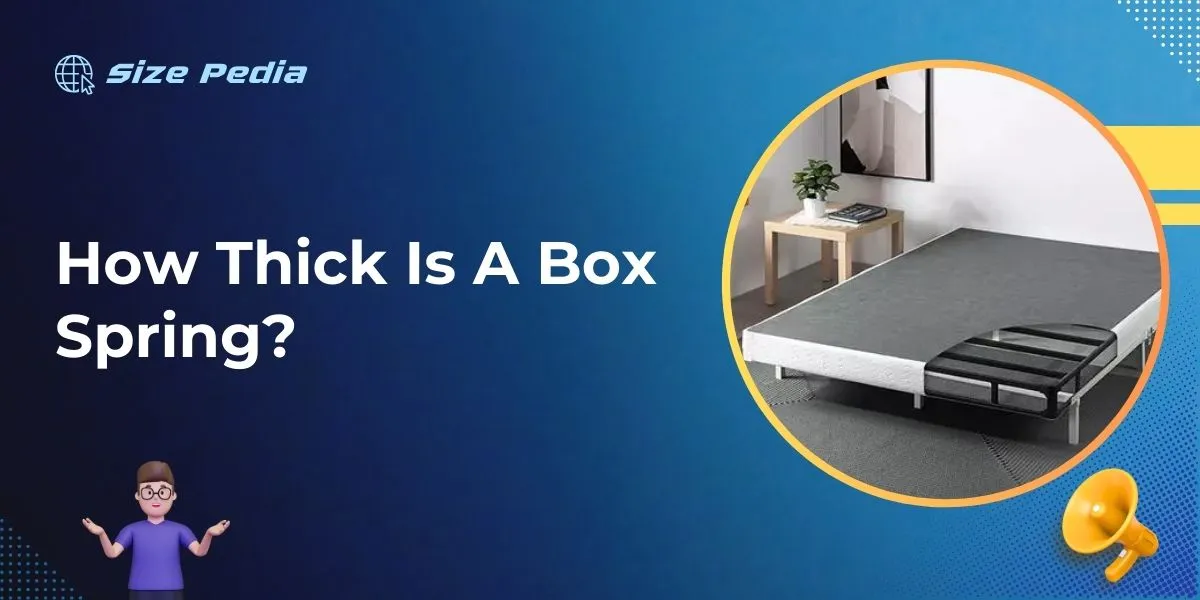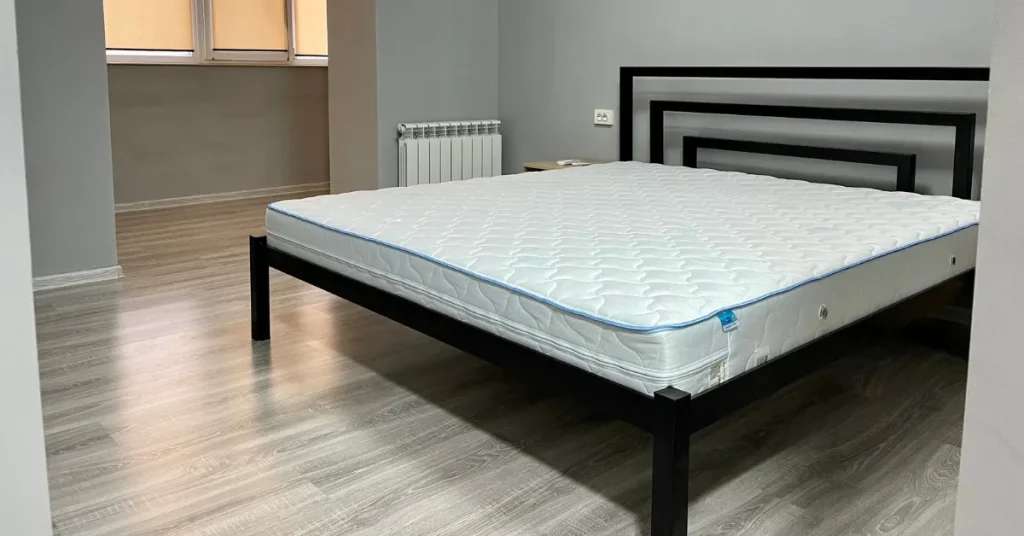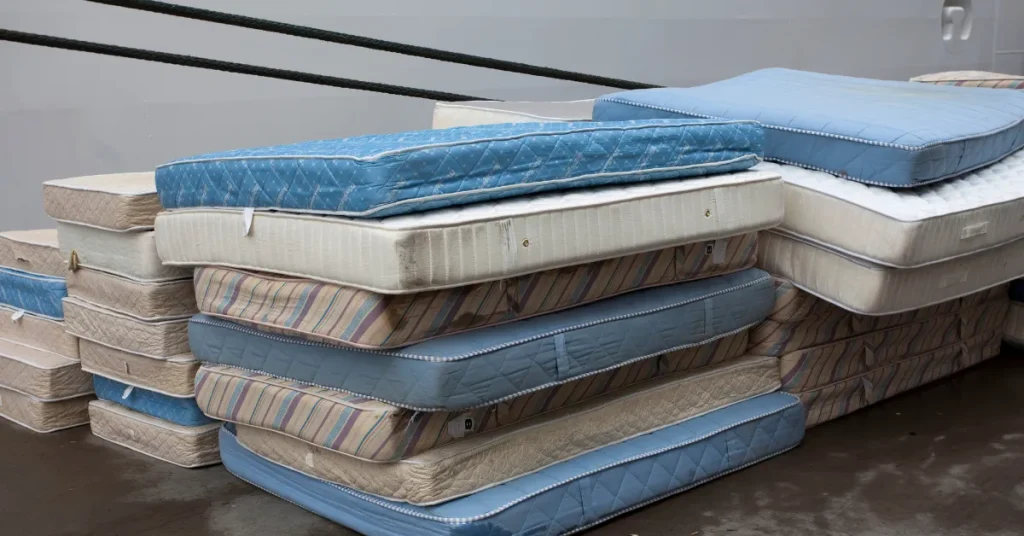A standard box spring is usually between 5 to 9 inches thick. This bedroom essential is designed to support your mattress effectively.
Box springs play a crucial role in mattress support and longevity, offering a sturdy foundation that can absorb shock and reduce wear.
They come in various thicknesses to suit different bed types and preferences, contributing not only to the comfort but also to the overall height of the bed.
A thinner box spring, around 5 inches, pairs well with a thicker mattress, ensuring your bed doesn’t reach an unwieldy height. Conversely, a thicker box spring of about 9 inches is often matched with a thinner mattress to achieve a balanced feel.
No matter what thickness you choose, a good box spring can enhance your sleeping experience and improve the durability of your mattress.

The Role Of A Box Spring In Sleep Quality
The quality of sleep depends on various factors, with the foundation of your bed playing a crucial role. A box spring sits beneath the mattress to provide support, improve airflow, and absorb shock. It can significantly affect how you sleep.
Let’s delve into how a box spring contributes to sleep quality by supporting the mattress and extending its lifespan.
Supporting The Mattress
A sturdy box spring ensures even support for the mattress above. This helps maintain the mattress’s shape and prevents sagging. A consistent surface contributes to spinal alignment and reduces pressure points. Here’s how a box spring accomplishes this:
- Even weight distribution
- Increased mattress stability
- Promotion of proper back support
Better support translates to restful, uninterrupted sleep.
Extending Mattress Lifespan
Box springs absorb daily wear and tear, extending the life of a mattress. Reducing direct floor contact prevents moisture accumulation and temperature fluctuations, which can wear out a mattress prematurely. Here are benefits a box spring provides:
- Prevents sagging and indentations
- Shields against dust and pests
- Minimizes wear due to movement
Investing in a good box spring means you won’t have to replace your mattress as often. This equates to savings over time.
Typical Thickness Ranges Of Box Springs
When buying a box spring, thickness is key for comfort and bed height. Typical thickness ranges vary to suit different beds and preferences.
Standard Box Spring Sizes
Standard box springs, the traditional choice, have a typical thickness range. Most measure around 8 to 9 inches thick. These sizes are ideal for those who prefer a taller bed.
Here’s a quick reference for common sizes:
| Size | Approx. Thickness |
| Twin | 8-9 inches |
| Full | 8-9 inches |
| Queen | 8-9 inches |
| King | 8-9 inches |
Low-profile Options
Low-profile box springs are thinner alternatives. They range from 4 to 6 inches thick. These options work well with thicker mattresses or for those seeking a lower bed height.
- Twin: 4-6 inches
- Full: 4-6 inches
- Queen: 4-6 inches
- King: 4-6 inches
Critical Factors Influencing Box Spring Thickness

Choosing the right box spring thickness is crucial for your bedroom setup. Let’s dive into the critical factors that dictate how thick your box spring should be.
Different bed frames and mattresses call for various box spring dimensions. Finding the perfect match enhances comfort and extends the life of your bed.
Bed Frame Requirements
Bed frames set the stage for box spring thickness. They come with specific support structures. These structures dictate the height and size of box springs they can accommodate.
- Standard bed frames may require thicker box springs to reach a comfortable height.
- Platform beds might not need a box spring, or only a thin one for added support.
- Adjustable bases often skip box springs altogether.
| Bed Frame Type | Box Spring Thickness |
| Standard | 7-9 inches |
| Platform | 2-5 inches (optional) |
| Adjustable | Not applicable |
Mattress Type Compatibility
The type of mattress you own impacts the required box spring thickness. Certain mattresses pair well with specific box springs.
- Innerspring mattresses work best with standard box springs.
- Foam mattresses often need rigid, thin box springs.
- Hybrid mattresses can go with a range of thicknesses.
Consider the mattress height as well. A taller mattress may require a thinner box spring to keep the bed at a comfortable level. A shorter mattress could benefit from a thicker box spring for added height and support.
Measuring Your Box Spring Correctly
Knowing the thickness of your box spring is crucial. A proper measurement ensures the perfect fit for your bed setup. It impacts comfort and aesthetics. This guide walks you through the process in a few simple steps.
Tools Needed For Accurate Measurement
Before starting, you need the right tools:
- Tape measure: A flexible yet firm tape measure is key.
- Notebook: Keep track of the numbers.
- Pen or pencil: For recording your measurements.
Step-by-step Measurement Guide
Follow these steps to measure your box spring:
- Remove all bedding: Clear the area for a hassle-free process.
- Place your tape measure: Start from the bottom edge upwards.
- Read the measurement: Note the figure once you reach the top.
- Record the number: Write it down to avoid forgetting.
Repeat these steps if needed. Double-check for accuracy. Record the width and length using the same method. Now you know your box spring’s exact size!
Choosing The Right Box Spring Thickness

Choosing the right box spring thickness is crucial for your sleep quality and bedroom style. A box spring supports your mattress. It adds height to your bed. The thickness of the box spring affects comfort, support, and look of your bed.
Personal Comfort Preferences
Think about how you sleep. Box springs come in different thicknesses. They change the feel of your bed. Choose a thicker one for more bounce. Opt for something thinner for a firmer base.
- Low-profile box springs are often 4-6 inches thick.
- Standard box springs are about 8-9 inches thick.
- Bigger isn’t always better. Match the thickness to your personal comfort.
Aesthetic Considerations And Bed Height
Box spring thickness can change your room’s look. Bed height adds to bedroom aesthetics. Match your box spring to your bed frame and your room’s style.
| Box Spring Type | Height | Good For |
| Low-profile | 4-6 inches | Sleek, modern rooms |
| Standard | 8-9 inches | Traditional, higher beds |
Consider bed height for these reasons:
- Easy to get in and out of bed.
- Storage under the bed.
- Suits your room’s style and furniture.
Think of your room’s total look before choosing. The right box spring can complete your bedroom.
Maintenance Tips For Longevity
Maintenance is key to ensuring the longevity of any household item, and box springs are no exception. Proper care can significantly extend the life of your box spring, making sure it provides the necessary support and comfort for a good night’s rest.
The thickness of a box spring may vary, but regardless of size, some fundamental maintenance tips can help keep it in prime condition.
Regular Cleaning And Care
Regular cleaning is vital for keeping your box spring free from dust and allergens. Below are straightforward steps to maintain a clean box spring:
- Vacuum monthly to remove dust and debris.
- Use a mild detergent to spot clean stains.
- Ensure adequate air circulation around and beneath the box spring to prevent moisture buildup.
- Protect it with a breathable cover to guard against dirt and spills.
When To Replace Your Box Spring
Box springs generally last around 8-10 years. Look out for these signs to know when it’s time for a replacement:
- Squeaks or creaks when you move.
- Visible sagging or wear in the middle area.
- Bent or broken steel coils or frame.
- Increased allergy symptoms which may suggest allergen buildup.
Remember, pairing a good quality box spring with your mattress can enhance support and contribute to a restorative sleep experience.
Heed these maintenance tips to ensure that your box spring remains a strong foundation for years to come.
FAQs About How Thick Is A Box Spring
How Thick Is A Standard Boxspring?
A standard box spring is typically around 9 inches thick. Some low-profile models may be 5 to 5. 5 inches thick.
How Thick Should A Mattress Be Without A Box Spring?
A mattress without a box spring should ideally be 8 to 14 inches thick to provide ample support and comfort. Choose the higher end for better cushioning without a base.
What Is The Thickness Of A Spring Mattress?
The thickness of spring mattresses varies, typically ranging from 6 to 14 inches. Your choice depends on personal comfort preferences and the desired level of support.
How Thin Can Box Springs Be?
Box springs can be as thin as 4 inches, accommodating various bed frame heights. Ultra-low-profile options also exist at 2 inches for a minimalistic setup.
Conclusion
Understanding box spring thickness is critical to supporting your mattress. It ensures restful sleep and long-lasting comfort.
Typically ranging from 4 to 9 inches, your choice should match your bed frame and comfort needs. Make an informed decision and enjoy a better night’s sleep.
Choose wisely for optimal support and durability.
Resources:
1. https://www.sandiego.gov/insidesd/free-mattress-and-box-spring-recycling-new-collection-site
